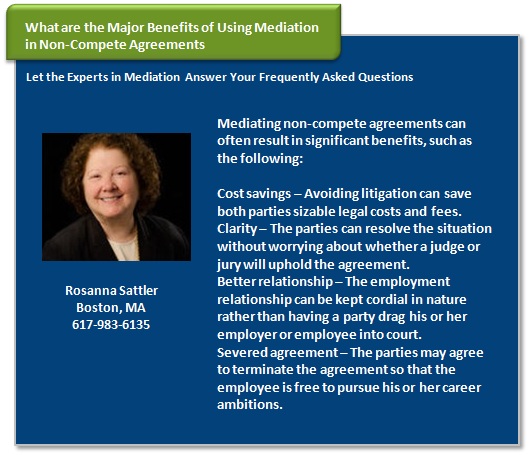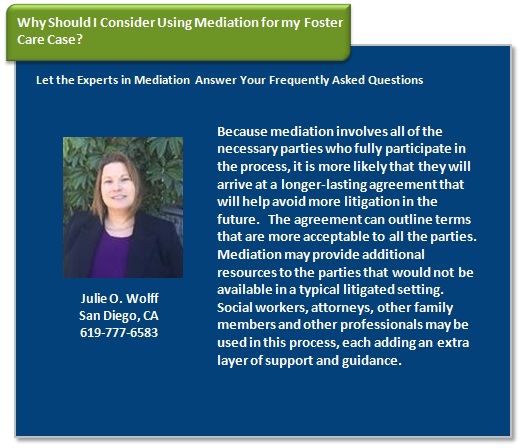
Julie O. Wolff

Possible Solutions to Non-Compete Issues

Due to the competitive nature in many industries, many employers have employees sign non-compete agreements. These agreements prohibit the employee from working for competitors or opening his or her own business in the same industry. The requirements of these types of agreements are based on state law, but generally there must be reasonable limitations in relation to the scope, geography and time constraints. Additionally, the employer must have something to protect that justifies the non-compete agreement.
When the employer and former employee are at odds over a non-compete agreement, they may use mediation as a way to resolve these differences. Mediation can help the parties avoid costly litigation or the possibility that the outcome will not be as they intended. Through mediation, the parties may consider possible solutions to their dispute, such as:
Eliminating the Agreement
The parties may decide that the agreement is no longer necessary. The industry may have changed, or the agreement may no longer serve the intended purposes of the parties. They may mutually agree not to honor the agreement.
Altering the Agreement
The employer may agree that the original agreement is broader than necessary. As such, the parties may agree to make adjustments. For example, the employer may alter the agreement to be valid for two years instead of three. It may condense the geographic region that is covered so the former employee has the option to pursue new opportunities.
Reciprocal Referrals
The parties may agree to provide referrals to each other for jobs that they are not able to complete or that may not be appropriate for them. This can allow them to have an ongoing, positive relationship rather than to be adversaries to each other.
September 15, 2017
Mortgage Assistance Available In The Wake Of Hurricane Irma – MIAMI (CBSMiami) – Florida homeowners who may have trouble making their mortgage payments after Hurricane Irma could be eligible for a mortgage loan deferment.
Looking to buy cheap? Consider a foreclosure … carefully – If home owners fail to pay their mortgage and can’t pay off outstanding debt, or arrange with the bank to sell the property at a loss, the home goes into mortgage foreclosure. The process from unpaid mortgage to auction can take more than a year, during which owners often don’t maintain the property. If a home doesn’t sell at auction, the lender, usually a bank, assumes the property and puts it on the market.
I Racked Up $10K Of Debt Traveling The World–Here’s What I Learned While Paying It Off – Credit card debt was a vicious cycle. I could only pay the interest each month, so I never made a dent on the balance. All my cash was going to payments, so I was never able to save. When an unplanned expense cropped up (did I mention I drove a ‘98 Buick LeSabre?) I couldn’t cover it, and had to use the credit card again. Before long, I was in more than $10,000 of debt. I had to make changes, fast.
Formulating a Child Safety Plan in Foster Care Mediation
 Many children are placed in foster care after Child Protective Services or a similar agency removes them from their natural home because of concerns about the child’s safety or wellbeing. This can often launch a daunting legal proceeding in which parents must prove they have remedied the situation so that the children can be returned to a safe environment. Mediation can be used as an alternative to this formal and stressful litigated process.
Many children are placed in foster care after Child Protective Services or a similar agency removes them from their natural home because of concerns about the child’s safety or wellbeing. This can often launch a daunting legal proceeding in which parents must prove they have remedied the situation so that the children can be returned to a safe environment. Mediation can be used as an alternative to this formal and stressful litigated process.
The mediation process is a voluntary process that involves the parties working together with a neutral third party who is skilled at conflict resolution. The parties work together to form a safety plan that is in the best interests of the child. This process can help the parties avoid adversarial court battles while being an inherent part of the solution.
Mediation allows the parties to work together to create a child safety plan that is tailored to the unique needs of the family. Rather than pitting biological parents and foster parents against each other, the process brings them together to work together toward mutual goals. The parties can have objective focus on what is best for the children and use this focus to guide the process. Because the parties are part of the solution, they can all feel that they have accomplished meaningful goals by working together rather than making parents feel that they are deficient or are being judged. Additionally, because the parties help come up with the plan, they are more likely to make strides towards accomplishing the objectives in the plan and to comply with it since they had a hand in drafting it.
Having a child-centered focus that is based on collaboration between the parties can serve as an effective alternative to litigation that addresses child protection cases to the benefit of all parties concerned.
Using Mediation in Foster Care Cases
 Mediation is an effective tool when dealing with family law issues. In the last few years, the use of mediation in foster care, adoption and dependency and neglect cases has risen exponentially. More communities recognize the efficacy of this tool, spurring them to adopt new mediation programs to address these issues. The traditional adversarial process involved in foster care and child protection cases often has inherent shortcomings that do not serve the best interests of the child or the parties involved. As such, mediation provides an effective alternative.
Mediation is an effective tool when dealing with family law issues. In the last few years, the use of mediation in foster care, adoption and dependency and neglect cases has risen exponentially. More communities recognize the efficacy of this tool, spurring them to adopt new mediation programs to address these issues. The traditional adversarial process involved in foster care and child protection cases often has inherent shortcomings that do not serve the best interests of the child or the parties involved. As such, mediation provides an effective alternative.
In mediation, the parties can freely discuss the issues that are important to them. The process is confidential, so they do not have to worry about saying things that can be used against them in court. Biological parents and foster parents may have grievances to air and concerns they wish to address, such as drug problems, discipline issues or a lack of contact. They can also communicate about difficult emotions in a safe environment. Meanwhile, attorneys involved can work together to solve the unique problems facing the family in an honest and candid manner without being concerned about how these issues will reflect on their clients in a court setting.
Foster care mediation involves specially trained objective professionals who help facilitate communication between the parties. Other people concerned about the child’s welfare may also be brought into the conversation, such as social workers or extended family members. During the mediation process, the mediator helps identify issues that need to be resolved. He or she then helps the parties solve these problems. Solutions may involve creating a safety plan, establishing a visitation schedule, considering how to address financial needs and other creative solutions. If the parties are able to reach an agreement, this agreement is memorialized in writing.
September 8, 2017
Fifty–fifty split better for children of divorce – Young children whose parents are divorced should split their time equally between both parents’ homes, a study has found.
Why filing bankruptcy may not necessarily stop a home foreclosure – There is at least one thing that you must know about bankruptcy and how it affects home mortgages: A person goes through the bankruptcy process, not the property. That is to say, when you filed for Chapter 7 bankruptcy, you went through the process and the bankruptcy court cleared you of all obligations to pay debts that you owed. The court discharged all of your prior debts.
Mortgage rates follow bond yields down to a 10-month low – Rates for home loans lurched to a fresh 2017 low, trailing bond yields in the wake of new geopolitical fears and lingering monetary stimulus, mortgage provider Freddie Mac said Thursday.
September 8, 2017




